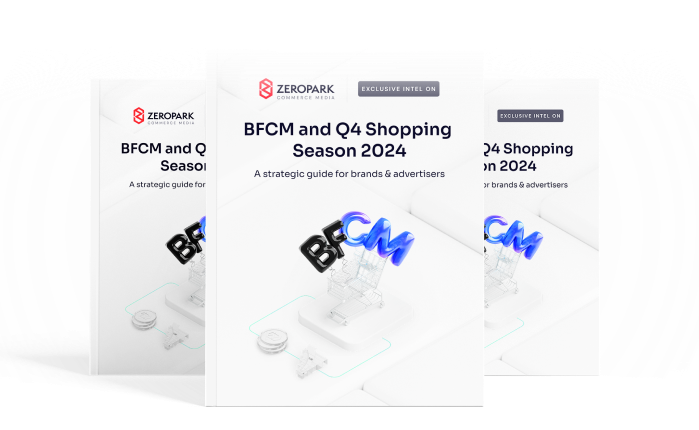The question of which type of traffic converts best, most definitely keeps affiliate marketers awake at night. As we don’t want you to suffer from insomnia, we’ve come up with a cure to aid your advertising efforts.
Whether it’s better to run an affiliate marketing ad campaign with domain redirect or pop traffic depends on many factors. Having already dug into the subject of domain redirect traffic, we’ve decided to set it side by side with pop and help you identify where the two differ and where they agree.
Read on and decide which one is a better fit for your campaigns!
Domain traffic ad campaign – a brief reminder
Domain redirect traffic, also known as domain redirect or zero-click traffic, is a type of traffic based on user redirection. A redirection is initiated when a user types in an unused/parked domain URL (usually by misspelling) in the address bar of a browser. As the website loads, a real-time bidding (RTB) auction among the advertisers begins and a user gets redirected to the highest bidder’s advertised website.
What’s important about zero-click advertising is the fact that the triggered redirections are caused by the user’s proactive search. This gives us an opportunity to target an audience who’s already interested in certain products/verticals. When combined with proper campaign targeting and optimization, zero-click traffic gives advertisers a greater chance of meeting the right traffic with the right offers.

Pop traffic isn’t dead
Pop traffic is one of the most popular ad formats in the affiliate marketing industry. This type of traffic comes from various types of pop ads. The two most common are, of course, pop-ups and popunders. Pop ads may be initiated in numerous ways, i.e. triggered automatically during a user’s browsing session (due to a toolbar or a plugin they have installed in their browser) or due to a user’s click onto a designated part of a website.
When triggered on desktop, a new browser window appears over a currently viewed page (pop-ups) or beneath it (popunders). On mobile, it’s usually a new tab opening in our existing browsing window. A user is either automatically taken to the new tab (tab-up) or a new tab is opened next to the current one, with no further action (tab-under). Advertised content is typically displayed either in the form of a landing page or an offer page.
Want to know more about pop traffic?
Read the ultimate guide to pop advertising!
Is it volume you’re looking for?
Both domain redirect and pop advertising offer large volumes of traffic. It is evident, though, that pop’s volumes are much bigger, with more than 43 billion available redirects monthly on pop vs. almost 1,5 billion on domain redirect (as estimated with Traffic Calculator). This, again, is due to the traffic’s nature. Zero click traffic offers a smaller, yet better-targeted audience, while pop traffic offers a significantly larger number of potential users, despite its targeting being much more general. Hence, bigger volumes of users need to see your pop ads in order to convert, than with well-targetable domain redirect campaign.
Cost-Per-What? Understanding cost models in Pop and Domain Ads
Most of the ad networks allow Cost-Per-Click or Cost-Per-Mille cost models for domain redirect traffic and pop traffic. Real-Time-Bidding (RTB) auctions take place in the same way for both options. Though, a substantial difference in the average bid price may be observed. If we take an example of:
- GEO: US
- Device Type: Desktop
- Traffic Type: Adult
- The average bid on domain is $0,0119 with the volume of ca. 4 million visits monthly.
- The average bid on pop is $0,0015 with the volume of ca. 775 million visits monthly.
Hence, due to the varied pricing, $100 can buy us almost 8,5k visits on domain redirect compared with more than 66k visits on pop.
 Landers – creative boost to your campaign
Landers – creative boost to your campaign
As clever affiliate marketers, we also need to give a little push to our creative side. This is because landing pages play a huge role in the success of the two types of advertising traffic. Although their purpose is the same — get a user to convert — the ultimate goal is reached with different means.
While good quality landers for both domain redirect campaign and pop advertising campaign need to include crisp copy, easy navigation, engaging visuals as well as clear and relevant CTA – adding on relevant links is mostly attributed to zero click advertising. In turn, a greater focus on visuals and CTA is placed with pop ads. Of course, shady practices of tricking users into clicking the wrong buttons or disruptive visuals are a common trait of pop-up advertising, especially the intrusive ones. Yet, the decision whether to use such techniques or not is left wholly up to you and the type of affiliate campaign you’re running.
Tiers, Inventories, Traffic Types, Verticals … and all that jazz
Whereas tiers, inventories, traffic types and verticals don’t exert such a great impact on the price of domain redirect traffic, it’s slightly different with pop ads. For pop traffic, various inventories offered by ad networks (meaning targets selected on the basis of their performance in given GEOs, then divided into Tiers) give affiliates instant information as to potential costs, volume and performance of pop traffic – thus being a huge help in estimating your advertising budget.
So, with zero click, we can research US GEO, belonging to Tier 1, with Dating vertical, and the information we thus obtain may help us estimate the optimum bidding strategy or overall cost of our affiliate campaign, though campaign optimization settings need to be done manually or with the help of optimization automation tools.
When similar research is performed for pop traffic, information about US GEO, belonging to Tier 1, with Dating vertical, it gives us not only the optimum bidding strategy data or overall cost estimation, but allows us to buy pop ads traffic only from these selected tiers and inventories. Such a selection can then be used to run highly profitable pop advertising campaigns with a proven ROI, while resting assured that your budget won’t burn through within split seconds.
Regarding verticals, these remain quite similar for both pop and domain redirect advertising. The best-performing ones are generally: downloads, push subscriptions, antivirus, e-commerce, dating, surveys and sweeps. Accounting for such data seems like good practice when considering campaign targeting and optimization strategies for both — domain redirect and pop campaigns.
Pop and zero-click traffic targeting
The above doesn’t mean, of course, that domain redirect falls behind in any way. Again, this depends on the type of traffic you choose to pursue and the campaign’s objective. As much as pop traffic gives you a chance to play with tiers and various Inventories, domain redirect’s targeting options are of undeniable benefit when turning your zero click campaigns into success. Let’s have a look at some mutual and domain-exclusive targeting options ad networks offer.
- Both pop advertising and domain can be run on Run-of-Network (RON), GEO, Target/Source or Keyword targeting.
- Pop allows you to buy much bigger volumes of traffic for a cheaper price – useful for running RON tests and Target/Source.
- Zero-click traffic allows for reaching audiences performing a proactive search themselves, thus securing higher interest in viewed offers, if well-targeted – useful with a proven Target/Source and Keywords.
- Pop offers tiers, inventory types and verticals differentiated in price and performance – useful for sure-fire solutions with RON and GEO.
- Domain redirect ads have greater chances of getting high engagement due to their relevancy and lack of redirect blocking. Hence the higher price, bringing quality traffic with higher-guaranteed ROI.
Estimating campaign budget for Pop and Domain Traffic
Selected inventories, traffic types, tiers, verticals, volumes or simply price per average bid — it all influences the overall cost of your affiliate campaign. Bear that in mind when trying to estimate your campaign budget. When assessing which traffic is cheaper or more profitable, pop traffic and domain redirect need to be juxtaposed with these principal differences.
Firstly, $100 will definitely buy you way more traffic with pop advertising than with zero-click, which might be very useful for running tests (if that’s your objective). Secondly, pop’s average bid price is significantly lower than zero-click traffic bid price. This is because pop ads require much bigger volumes of traffic to get actual views than domain redirect, which may be caused by browsers’ default or manual blocking of pop ads, which isn’t the case with domain redirect. Be aware also, mobile pop traffic has become quite a crowded place for displaying ads recently since this is where all the people are at, thus inflating the bid price.
All said, the overall cost of both zero-click advertising campaigns and pop ads campaigns stays similar. Which traffic turns up more profitable for your investment depends solely on the type and purpose of the campaign you’re running — testing-focused or a precisely targeted one.
Find a niche, know your audience
In order to succeed, a clever affiliate has to find his niche and understand its target audience – this is universal to all traffic types. In this way, optimization, targeting, bidding strategies, creatives and all other factors come together, making for a profitable campaign fall into place. Sounds quite easy and logical, but how do affiliate industry sharks navigate so brilliantly?
Read The Ultimate Guide To Domain Redirect Advertising Here!
Feeling you’ve heard it somewhere before? Well, nothing has changed, the same golden rule still applies — RESEARCH, TESTS, OPTIMIZE and PROFIT. Remember, this is common for all traffic types, including pop advertising and domain redirect. These two can truly give you all the data you need to figure out a strategy that works best for you, as well as help you identify the key focus areas.
Nail it like industry sharks
This is why e.g. verticals, tiers, or whitelists may come in really handy — they give you a hint of what kind of audience to expect. Focus on such areas, monitor trends, and react accordingly.

How?
- See which verticals, tiers, GEOs and sources perform well and which don’t.
- Identify your audience by researching excelling items.
- Pause or add GEOs/Keywords/Target/Sources.
- Bid up or Bid down.
Also:
- Make full use of automation tools like rule-based optimization offered by some ad networks.
- Improve your landing/offer pages according to the target audience specification.
- Work on the right CTAs!
Decision time
As only you know what exactly you’re striving for with your affiliate marketing campaigns, we cannot decide which traffic type is the best for you. Whether that’s pop or domain redirect traffic, depends on your goals, strategies, experience, practices, and budget.
All that and constant researching of industry trends increases the odds of every clever affiliate to invest in watertight solutions. Perform a little due diligence, search industry forums, ask your account manager or read affiliate blogs to find out. Staying up to date is synonymous to staying ahead of the curve.
Have you decided what works best for you?
Are you Team Pop Ads?
See how Zeropark’s Pop Traffic Can Help You Boost Your Profits!
Want to Try Domain Redirect Ads?
Try out Zeropark’s Zero-Click Traffic!
Kinga Gawron







